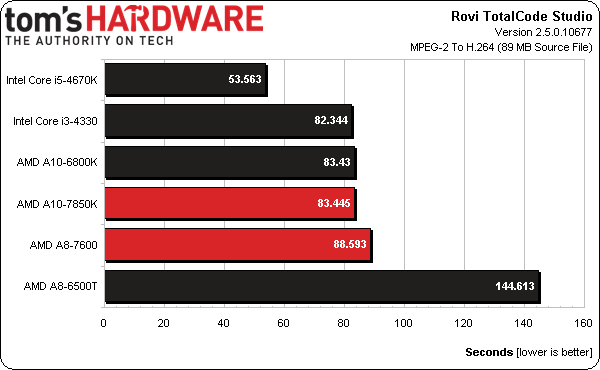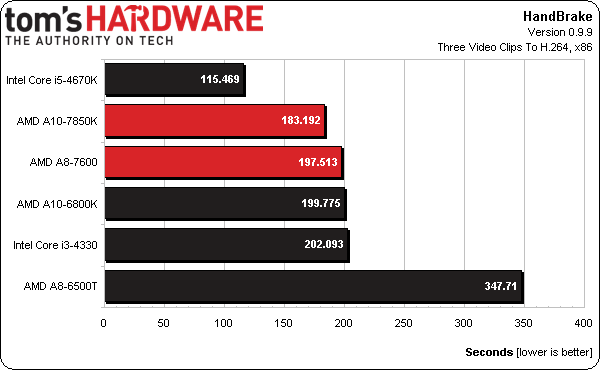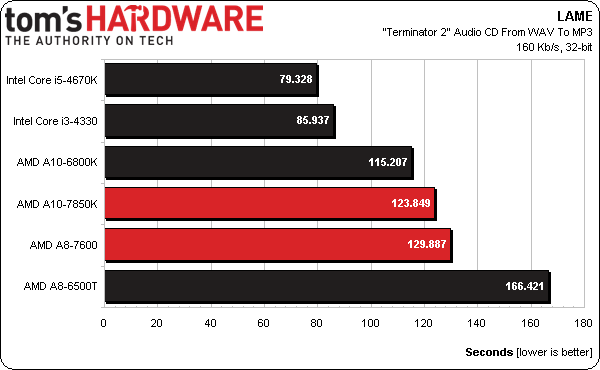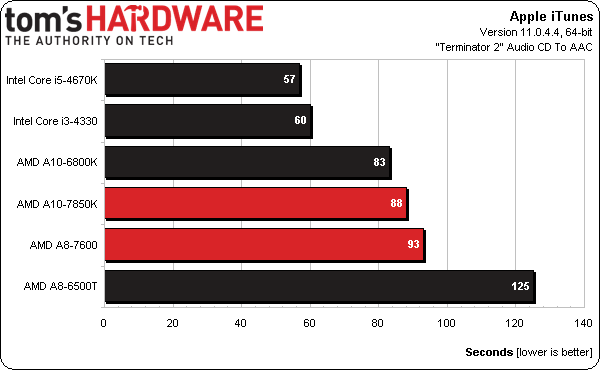AMD A10-7850K And A8-7600: Kaveri Gives Us A Taste Of HSA
We've spent the days following CES benchmarking two of AMD's new Kaveri-based APUs. Do the Steamroller x86 architecture, GCN graphics design, and HSA-oriented features impress, or do they come up short against Intel's value-oriented Haswell-based parts?
Results: Media Encoding
The benchmarks on this page employ workloads that we imagine are high on AMD’s list of tasks to accelerate through OpenCL, and ultimately to optimize for its HSA features. In fact, there’s already a beta version of HandBrake with OpenCL-based optimizations that offload cropping and down-scaling to the GPU.
At least in TotalCode Studio, however, encoding happens on x86 cores. This application leverage’s Rovi’s popular MainConcept codecs, which run well on Intel’s Core i5-4670K. The dual-core Core i3 and dual-module A10 and A8 APUs all turn in very similar results. Only the 45 W A8-6500T is completely blown away.
Switch over to the -7600 with a 45 W ceiling and you can take that 144-second finish time down to 98 seconds. We've already pointed this out several times, but AMD says it optimized Kaveri for that 45 W ceiling. In this case, those improvements cut 31% from the test's completion time.
Although we’re not using the OpenCL-accelerated beta of HandBrake, the stable version in our suite does explicitly leverage Kaveri’s support for FMA3/4, LZCNT, and BMI1. Then again, so does Richland’s Piledriver architecture.
Either way, A10-7850K manages a win against -6800K (for that matter, A8-7600 does too).
Dialed down to 45 W, the -7600 finishes in 213 seconds. Compared to the other 45 W part in our chart, AMD’s A8-6500T, that’s a phenomenal improvement. It’s just particularly sexy in a desktop environment.
Our LAME audio conversion test is single-threaded. It’ll allow each of these CPUs to spin up to their maximum Turbo Boost or Core frequency (unlike the per-cycle comparison we ran earlier, which sought to compare architectural efficiency at a fixed 4 GHz).
Get Tom's Hardware's best news and in-depth reviews, straight to your inbox.
Intel’s Haswell design maintains its advantage. Richland, as it appears on the A10-6800K, hits higher clock rates and therefore is faster than Kaveri.
Again, curious as to how the 45 W version of A8-7600 would size up with its peak clock rate constrained to 3.3 GHz, I adjusted down the configurable TDP in ASRock’s firmware. The outcome was a finish time of 139 seconds—an impressive improvement over the A8-6500T standing in as our 45 W Richland-based APU.
The same story applies to iTunes, which is also single-threaded.
Current page: Results: Media Encoding
Prev Page Results: Compression Apps Next Page Results: Power Consumption And Efficiency



